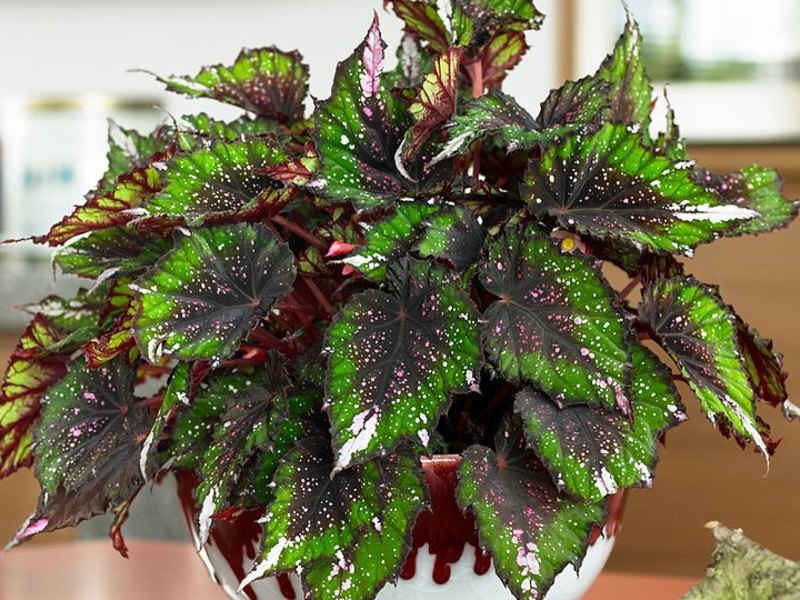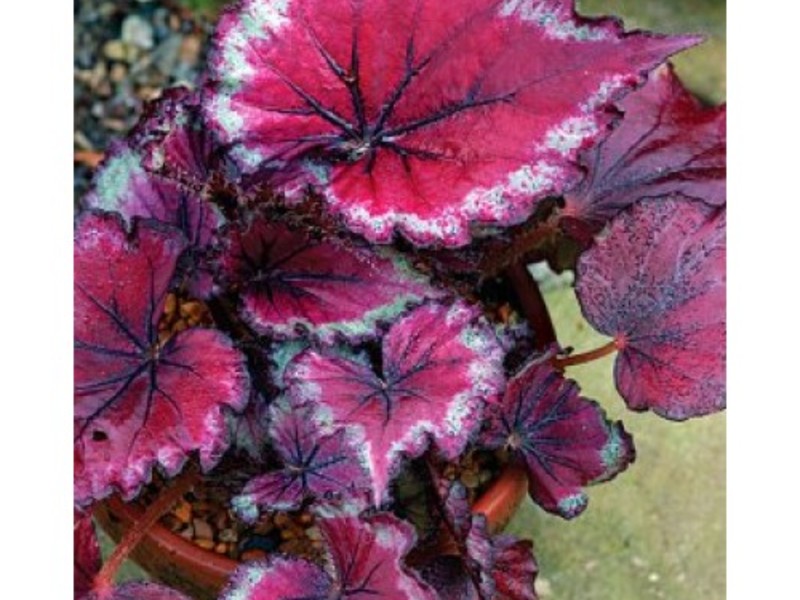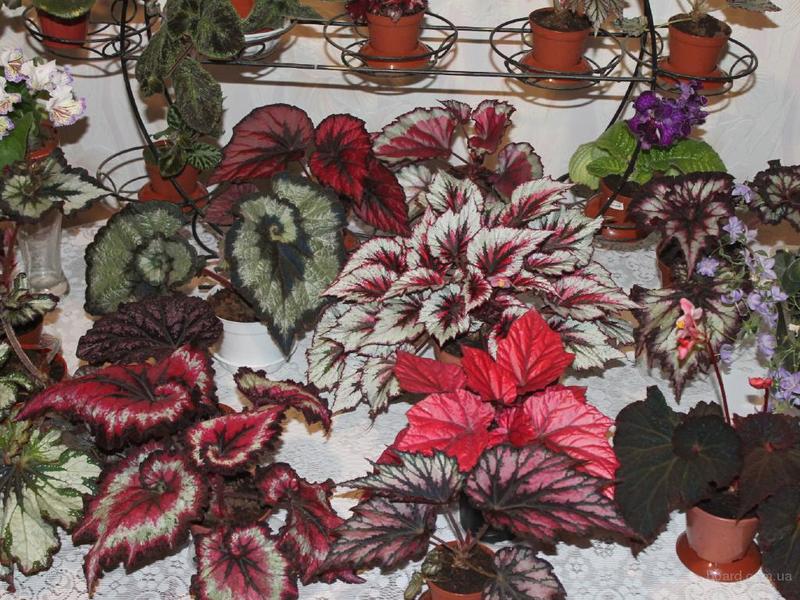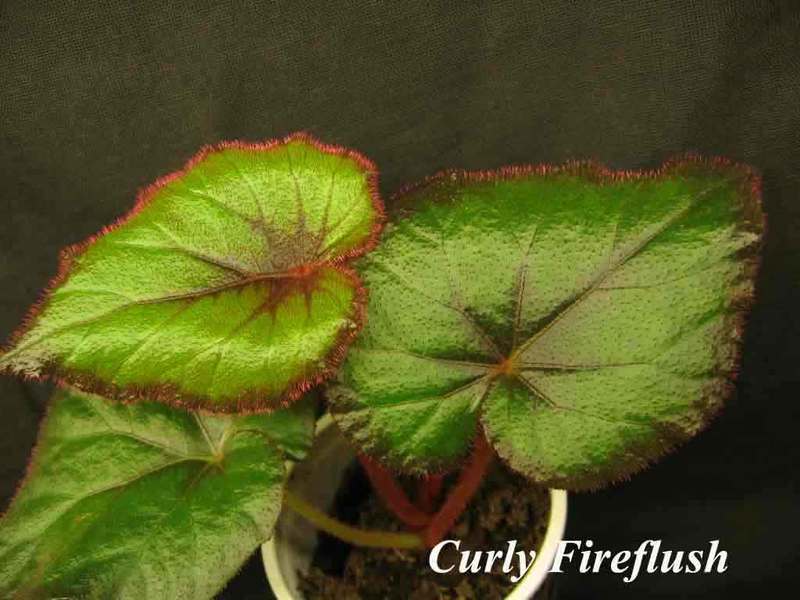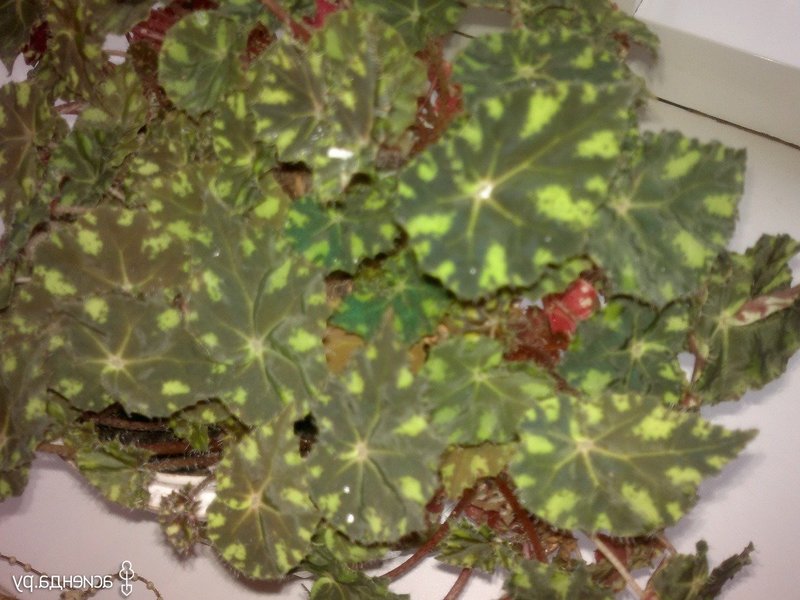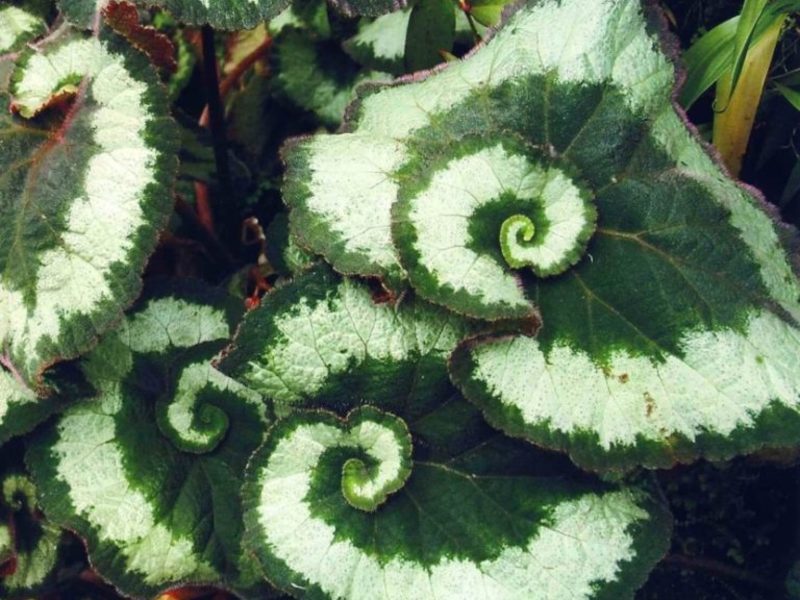Diseases and pests
Too humid air and excess watering in winter will lead to powdery mildew: plaque appears on the leaves, and they die off.
In dry air, the edges of the leaves dry out and turn brown. With a lack of lighting, the leaves stretch out, become small and pale.
In the summertime, aphids, which were accidentally brought from the street, can attack the begonia. The appearance of a spider mite is also likely - it loves dry air. To remove pests, Actellik is used, which is sprayed on the plant.
Begonia is an almost ideal plant for keeping at home or in the office. It looks great in green areas and conservatories.
Decorative leaf begonia purifies indoor air and helps fight harmful bacteria.
Reproduction
You can propagate a flower in three possible ways:
- With the help of cuttings;
- By dividing the tuber;
- Seeds.
Let's talk about all the methods in more detail.
Propagation by cuttings
Propagation using cuttings is a fairly simple method that is suitable for all types of this plant. It is better to prune cuttings in early spring. Cuttings up to 10 cm long are suitable for reproduction. The lower leaves must be removed, and the cuttings must be placed in a container with water or in the ground.
To accelerate the appearance of roots, you can use "Kornevin" or another growth stimulant. Usually, the roots appear after a week, after which the cuttings can be planted in the soil.
Rooting in the ground takes a little longer - after 4-5 weeks. For this, a favorable soil temperature should be ensured - 20-22 degrees.
Growing from seeds
The seed method is the most difficult in comparison with the others, because the seeds are quite small and sensitive to external factors.
Seed planting is done in January. The seeds are simply sown on the surface of the soil and lightly pressed against it. The container is covered with foil to create a greenhouse effect.
To get good results, you need to create the following conditions:
- Provide additional lighting for future plants (+ 4-5 hours to daylight), which contributes to subsequent flowering already in the year of sowing.
- Stick to a temperature of 22-25 degrees.
- Ventilate the crop container regularly.
After 2-3 weeks, the first shoots can be observed, after which the film can be gradually removed using special phytolamps.
After 3-4 leaves have formed, they can be planted in separate pots.
Tubers
This method only applies to tuberous begonias. For reproduction, large healthy tubers are selected, which have from 4 to 7 buds.
The procedure is pretty simple:
- Using a knife, the tuber is divided into parts so that each of them has buds.
- Allow the slices to dry for several hours, and then spread the tubers with their underside on moist soil or gauze soaked in water.
- Place the tubers in a warm, well-lit place and wait for the roots to appear.
- Spread the tubers into the prepared substrate and sprinkle a little earth around, while the upper part of the tuber should remain on the surface (2-3 cm below the edge of the pot).
- After the appearance of the first shoots, the tuber is completely covered with earth.
- Continue leaving as usual.
Care
Taking care of royal begonia at home is not so difficult. The main thing is to know some of the nuances of watering and feeding, as well as the selection of a suitable place to place the plant. Begonias are fairly light-loving plants, and it is because of this that they have such a juicy and bright color of leaves. Therefore, it is not recommended to place them in too dark areas of the dwelling. With a lack of light at any time of the year, the leaves of the plant can turn pale and even begin to dry. Wherein direct sunlight recommended to be avoided.Begonia leaves are quite delicate, with direct exposure to UV rays, burns may remain on them. In general, the ideal place to place a houseplant is partial shade with enough incident light.
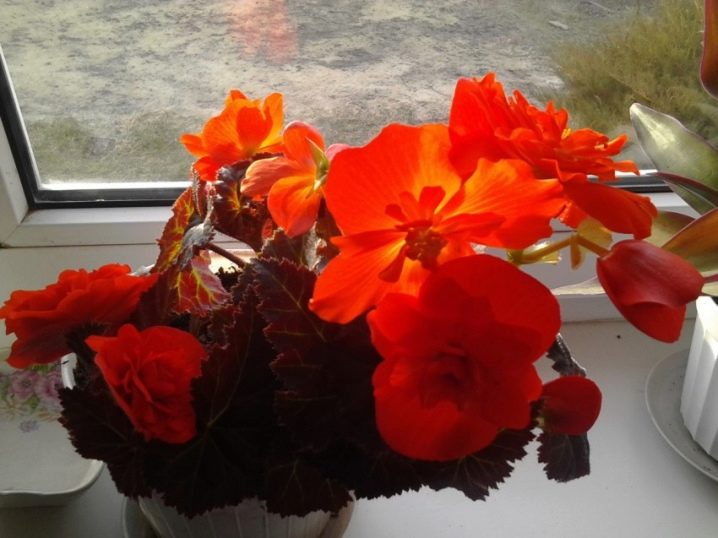
Royal begonia is tropical and therefore very thermophilic. The ideal temperature regime for its comfortable growth ranges from +15 to +25 degrees. Temperatures over 30 degrees and constant drafts are undesirable for her. In the summertime, pots with begonias can be taken out into the fresh air, but not in the open scorching sun. In winter, begonia can feel great on closed loggias, where the temperature fluctuates around + 16-17 degrees.

It is very important to properly water the plant and in no case overflow or flood it, otherwise excess moisture can lead to serious diseases and leaf discharge. In the summer, watering should be abundant, the soil should not be allowed to dry out
Typically, during the warmer months, it can vary from 2 to 4 times a week, depending on the age of the plant and the capacity in which it grows. Watering should be carried out with water at room temperature, preferably separated. Excessive moistening of begonias with a spray bottle is not recommended. This procedure can be carried out, but not very often.
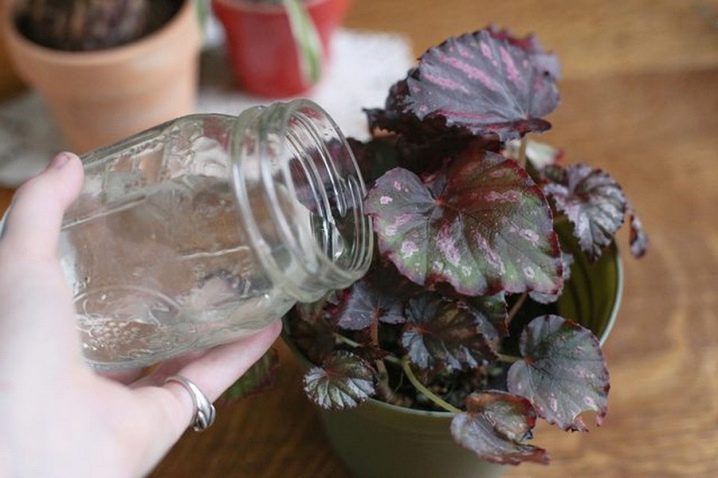
Velvet leaves of royal begonia very often collect dust from the air, thereby cleaning the room, so it is recommended to wipe them with a damp sponge or not a hard cloth about once every 2-3 weeks as it gets dirty
When performing any actions with the plant, including watering and cleaning, it is very important to remember that it is very fragile, so any manipulations should be done as carefully and carefully as possible.

To improve the quality of life of the plant, it is recommended to feed it. This can be done once a month or less often, but not more often. It is best to buy ready-made dressings in specialized stores. As preventive measures against diseases and pests, you can use herbal infusions, which not only do not harm the life of the plant, but also serve as a kind of natural feeding.
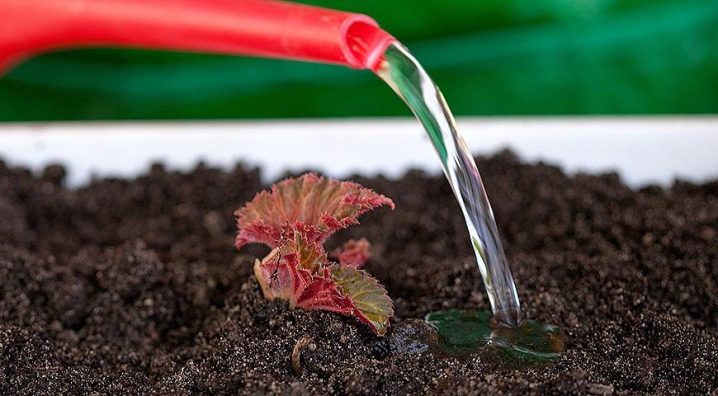
Decorative leafy begonias
The flowers of this group lack a common stem. Large leaf plates grow directly from the branched root. They are multi-colored, speckled and monochromatic. The foliage color ranges from dark green to red and silver. Some members of this group are in bloom. Popular varieties and types of begonias of this species: Rex, Metallicheskaya, Red-leaved, Tiger, Coral, Diadem, Barshevik-leaved, Collar (Cuff).
Royal
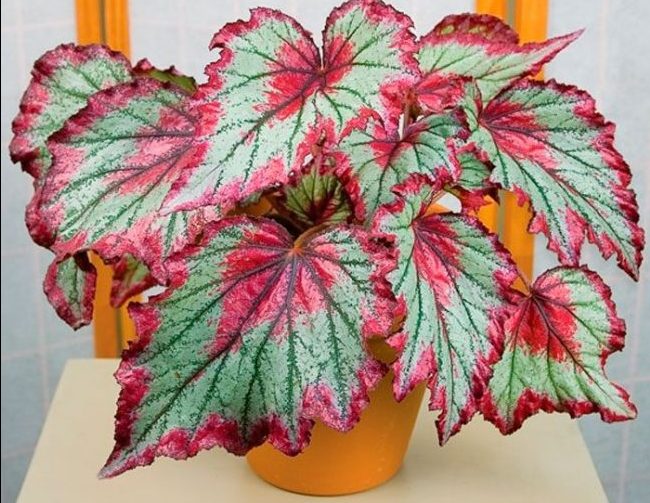 Royal
Royal
These are hybrids of the Begonia family. The second name is Begonia rex. The birthplace of the flower is East India. The roots of culture are creeping, powerful. Leaves are asymmetrical, cordate, with a rough surface. Their color ranges from green to purple. The leaf plates of most varieties have silvery spots. Stem - small, dense, covered with bristles. Peduncles are small, pink, up to 1 cm in size.
Grifon
 Grifon variety
Grifon variety
- Description: the trunk is dense, creeping, the foliage is large, carved. The color of the leaves is black-green with gray splashes. The maximum plant height is 41 cm.
- Care: watering as the soil dries, regular humidification of the air around the pot, fertilization for indoor plants.
- Conditions: it is recommended to place begonias in front of a light source and shade a little.
Escargot (Snail)
 Escargot
Escargot
- Description: leaf plates are asymmetric, spherical or ovoid, spiral wound. Their color ranges from purple to pink-brown, with white, green or silver borders. The foliage surface is matte with fine pile. The trunk is short, dense, covered with red hairs. Inflorescences are undeveloped, small, pink.
- Care: maintaining humidity at 50-60%, watering every other day in summer, as the soil dries up in winter.
- Conditions: shading is required from direct sunlight, maintaining a comfortable temperature - + 20˚C in winter, and + 30˚C in summer.
Tiger
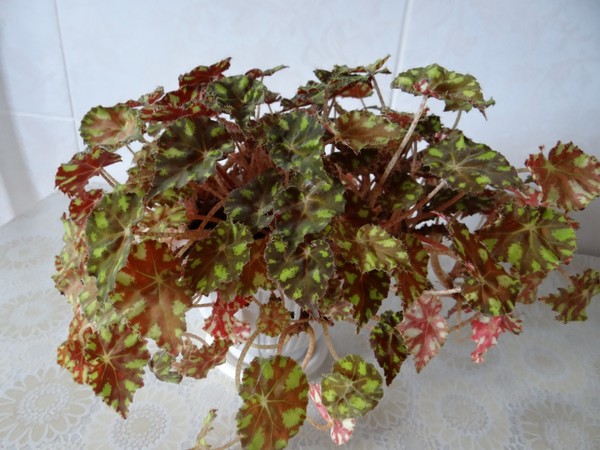 Tiger
Tiger
Perennial bush plant of the Begonia family. The second name is Bauer (Begonia bowerae). Tiger begonia is named for its spotted leaves. The maximum height of the bush is 30 cm. The surface of the leaf plates is fleecy. Inflorescences are inconspicuous, pale pink. The stem is straight, branching. The roots are branched, thin and delicate.
Tiger
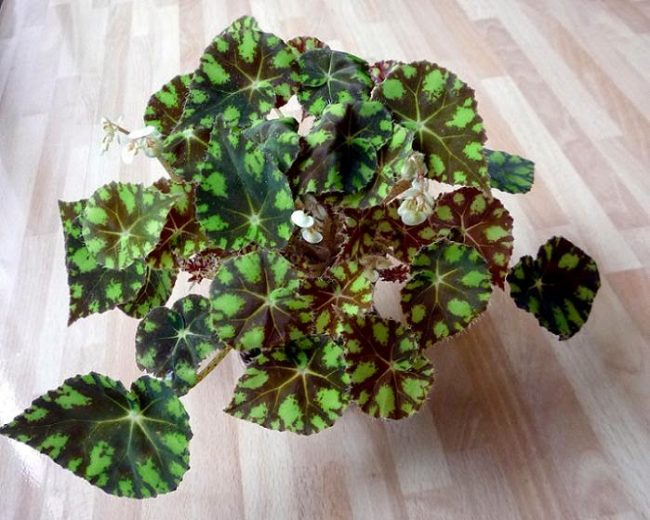 Tiger
Tiger
- Description: leaves - heart-shaped with beveled jagged edges, up to 8 cm long. Their colors are emerald green with black and red edging, light or dark green spots. Inflorescences are small, white or pink. The trunk is creeping, branching.
- Care: moderate watering, fertilization for indoor flowers (once a week).
- Conditions: shading from direct sunlight in spring and summer, maintaining the temperature + 16… 20˚C.
Cleopatra
 Cleopatra
Cleopatra
- Description: a decorative variety of indoor begonia, other names - Maple-leaved, Boveri.
- Type: bush height - 50 cm. The trunk is straight, thin, fleecy. The leaf plates are finger-shaped, pointed. Their color is olive green, with white stripes, on the back - burgundy. A kind of root system is a rosette. Inflorescences are small, pink with a yellow center.
- Care: watering - every three days in winter, three times a month in summer.
- Conditions: temperature regime - + 18… 25˚C.
Coral
At home, begonia grows up to 1 m. The plant propagates by cuttings, dividing the rhizome. The root system is fibrous. One of the subspecies of coral begonia is Alfalfa with large, fleshy, bright pink flowers.
Alfalfa
 Coral
Coral
- Description: trunk - naked, straight, leaves - wide, oval, sinewy, with jagged edges. Their length is up to 20 cm, color is dark green with cream or silvery blotches.
- Care: shading from direct sunlight, maintaining the temperature + 22..24˚C, watering every two days in summer, as needed in winter.
- Conditions: after flowering, the plant needs rest for at least 2 months.
A home ornamental plant native to Mexico. Its second name is Mason's begonia. The stem is creeping, thick, up to 4 cm in diameter. The leaf plates are large, up to 30 cm long. Their shape is finger-dissected, the color is dark green. The leaf lobes are round or oval, with jagged edges and veins. Flowers - small (0.5-1 cm in diameter), yellow-green, collected in a brush. This representative of the Begonievye family blooms from February to April.
Varieties
Bauer's begonia has several subspecies:
- Cleopatra;
- "Tiger";
- brindle;
- "Major";
- Apple Pie;
- begonia Rhinestone Jeans.
Cleopatra
This variety is an ornamental plant. It has small buds, colored white or pink. They bloom from mid-winter to mid-summer.
The leaf blades can be up to 15 centimeters in diameter. They resemble maple leaves in shape. They have a small fluffy bloom.
Leaves are colored green with a slight bronze sheen. If the flower constantly stands in an area with abundant lighting, then it will gradually change its color to light brown.
Cleopatra propagates by cuttings or rooted leaves. Sometimes the division of the rhizome or even the bush itself is used for this.

"Tiger"
In this type, the leaf plates are painted in a bronze-green color. Often this flower grows with large brown spots on the leaf blades. The leaves are small and oblique in shape. A strip of brown can be seen along all the veins. The stem of the plant grows branching and creeping.
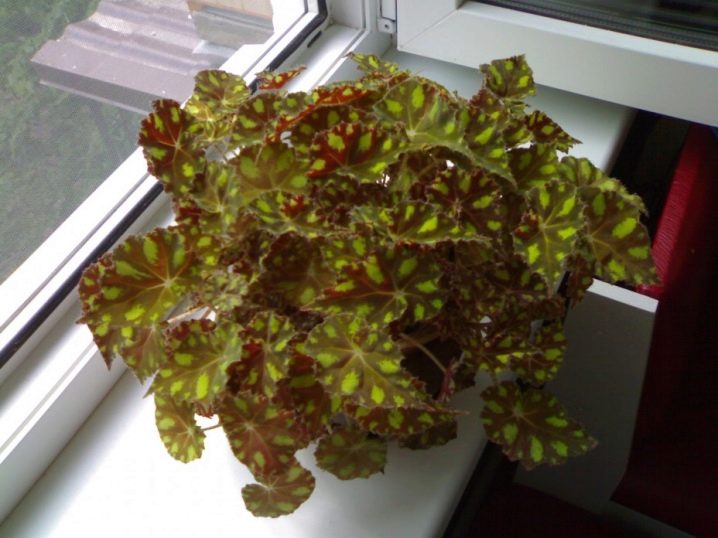
Tiger
The shape of the leaves in this species is heart-shaped. Their edges are jagged. They are painted dark green. The pattern on the plates is presented in the form of large spots of a light green hue.
The aboveground stem is absent. The elongated leaf grows from the root system of the plant.The height of the entire bush can reach no more than 30 centimeters. In winter, a flowering stem grows. White flowers are formed on it.
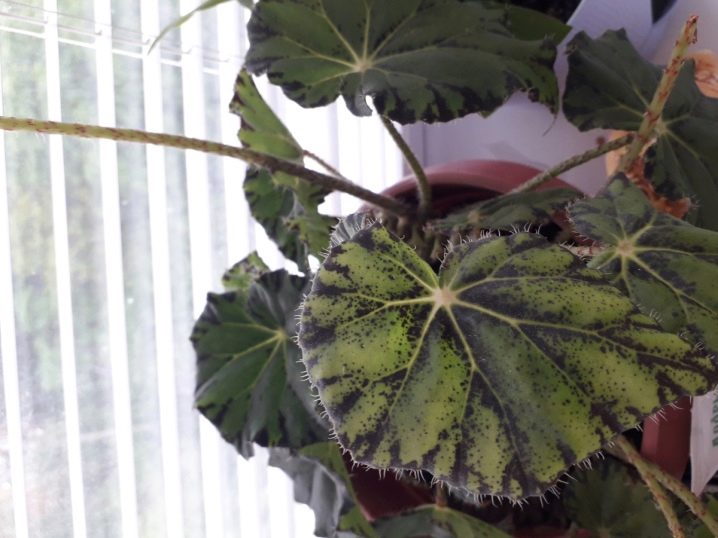
"Major"
Such an ornamental plant has small leaves of a light green color. Their edges are painted in a darker shade. Small bright pink spots can be seen on them. This species blooms with pink small flowers.

Apple Pie
This species has small dark green leaves with double edges. On the leaf blades along the veins, you can see stripes of a dark purple hue. Apple-pie blooms with white flowers.

Begonia Rhinestone Jeans
This variety is an ornamental small plant. The leaves are colored dark green with lighter edges. They are elongated and slightly pointed.

Terry mix begonia care at home
Growing begonias is not difficult, although this process requires competent care, attention, care and responsibility.
Landing
In home culture, they are grown using tubers or seeds.
Tubers are prepared in autumn (before the onset of cold weather). They are taken out of the ground, cleaned, and the stems removed. Store in a cool place (+8 +11) in containers with peat or sand. Planted from mid-February to May.
Seeds are sown in winter in a prepared mixture of leafy soil with the addition of peat and sand. The method is more troublesome and takes more time.
If you are going to transplant flowers on an open loggia, in a winter garden or a summer cottage, you need to do this in early or mid-May
It is important that the snow has had time to completely leave the site by this time, the frosts end at night, and the earth warms up well in the sun during the day.
Pot selection
It is advisable to give preference to containers made of environmentally friendly materials - clay or ceramic pots, which have porous walls and pass oxygen well to the roots. Can be grown in wooden pots with good drainage. Choose a shallow pot (10-14 cm).
Plastic doesn't fit. It is a cheap, dense, non-breathable material.
The soil
Light, porous soil rich in minerals is suitable. Oxygen must flow to the roots, moisture must not stagnate.
- You can purchase a ready-made earthen mixture for growing indoor plants. Add sand or brick chips to it for good drainage.
- You can cook it yourself from the greenhouse soil for indoor flowers, sifted sand, peat.
- It is imperative to make a dense drainage embankment at the bottom of the pot. Tuberous varieties are especially prone to flooding.
Watering
Water regularly and abundantly in the spring and summer (2 times a week). In winter - less often.
- Watch for soil moisture. The top layer of the earth should dry out well between waterings. Stagnant moisture can lead to root rot.
- Use only water that has settled and at room temperature.
Light mode
Terry begonia loves good, intense lighting. But, does not tolerate direct sunlight. Its leaves are very sensitive to overheating and burns.
- In the summertime, create diffused lighting conditions.
- If the flower is on the windowsill, periodically turn it with different sides to the sun. This promotes uniform growth and flowering.
- In winter, use additional artificial lighting if necessary.
Thermal conditions
The room should have a moderate, warm temperature (19-23 degrees). Begonia does not like hot, stuffy rooms with dry air.
- Ventilate the apartment often. At the same time, keep the plant away from drafts, cold winds, temperature drops.
- In warm summer weather, it will be useful to take the begonia out into the fresh air.
- In winter, the room temperature should not drop below 15 degrees.
Air humidity
The humidity should be high. At the same time, it is not recommended to spray the flower so that brown spots do not appear on the leaves. Get a floor-standing humidifier, spray the air around the flower, or place a container of water next to it.
Pruning
Begonia needs regular pruning, as it grows quickly and the stems begin to stretch out rapidly. The pruning procedure is useful for improving flowering, forming the crown of a young plant, rejuvenating and maintaining a decorative appearance.
- The first pruning is started when the stems grow to 7-8 cm. The bush needs to be shaped. After pruning, watering is temporarily reduced.
- When the lateral shoots reach 10-12 cm, their tops are trimmed. This will help the lateral buds to wake up.
- In the future, you need to monitor the appearance of the flower. Remove dried twigs, leaves and shoots.
- Pruning is carried out only with a sharp knife. Scissors or pruning shears cannot be used. It is useful to treat the cut sites with crushed charcoal to speed up the healing process.
Hybrids and types of begonias with photos
One of the most popular indoor species is the decorative deciduous Royal Begonia (Begonia rex) and its numerous hybrids, which will delight flower growers with spectacular patterns on the leaves with shades of green, gray, red, purple.
The plant grows to about 30 cm in height. The underground part is a rhizome. The leaves are large, fleshy, heart-shaped; nondescript flowers appear in summer. This type of plant reproduces vegetatively.
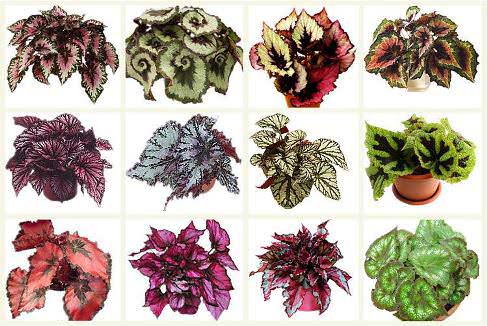 Begonia rex hybrids
Begonia rex hybrids
Begonia boweri. A small species in the form of a compact bush up to 30 cm in height. It is characterized by beautiful green leaves with a dark edge.
One of the popular hybrids is "Tiger" with a brownish-green leaf plate with light green spots. Loves partial shade. Propagated by dividing rhizomes and cuttings.
Begonia Mason. One of the most common varieties. Decorative wrinkled light green leaves with a dark brown pattern. The underground part is the rhizome.
Coral begonia (Begonia corallina). A charming species of upright shrub begonias with elongated green leaves dotted with small light specks.
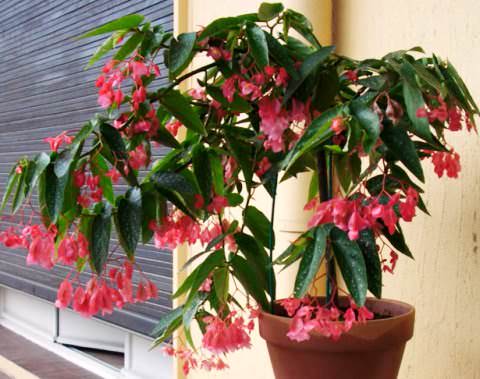 Begonia corallina
Begonia corallina
Begonia Elatior. The most magnificent decorative blooming hybrid of tuberous begonia. It is valued for its magnificent large double flowers against a background of glossy leaves. It is characterized by long flowering.
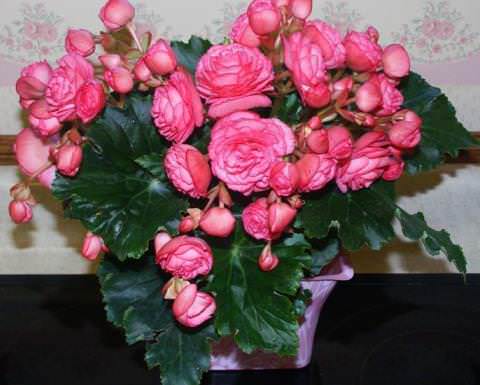 Home begonia Elatior
Home begonia Elatior
Noteworthy is the hybrid Lorraine, which can be grown at home. Its spectacular bloom lasts from October to December.
Types and their photos
Decorative
Ornamental begonia has no aerial stems at all, and pubescent leaves instantly grow from a branched root. This type of plant is able to amaze with its unusual beauty. Begonia leaves have different shapes and colors (read more about decorative deciduous begonias here). The leaves are painted in different colors:
- green;
- red;
- yellow;
- silvery;
- brown.
Leaves can be monochromatic, multi-colored, speckled and with edges.
Hybrid variety
The royal snail begonia is a hybrid species. It has rounded leaves up to 300 mm long with small denticles at the edges. The color of the leaves is brown, purple, violet. They are painted with a pale green, white, silver border.
Dark mambo
The plant has olive-green pubescent oval leaves, the edges are endowed with small teeth. The surface of the leaves of the metal begonia is covered with silvery pollen, resembling a metal formation.
For you, we have prepared information about other types of begonias. Find out more about these varieties: Metallic, Griffith, Griffin, Hogweed, Imperial.
Varieties and types of flowering begonias
When it comes to the species and varietal diversity of flowering begonias, one should prepare for uncertainty and confusion. The thing is that all modern begonias with beautiful flowering are hybrids. And even if we are talking about a specific variety, it is still presented for sale by varieties that have undergone a long and complex selection.
When choosing flowering begonias, it is not necessary to strictly follow the botanical name of plants, because often the same varieties in different catalogs are called differently. The main thing is the decorativeness of the plant. Begonias are chosen with heart and eyes, to your taste and for your interior.
The choice of flowering begonias is not limited by any parameter. Only by the color palette, they range from the brightest to the lightest and most unusual variations of white, yellow, pink, orange, red, purple colors, not to mention a variety of watercolor and contrasting two-tone combinations that further expand the color palette of beautifully flowering begonias.
 Begonia napellus, or ever-flowering begonia (Begonia cucullata)
Begonia napellus, or ever-flowering begonia (Begonia cucullata)
The most popular varieties of flowering begonias
Varieties of ever-flowering or ever-flowering begonias (today the species name Begonia cucullata is assigned, but it is still better known as Begonia semperflorens) is a hybrid type of begonias that were obtained by crossing more than 5 different Latin American varieties of begonias. These are shrubs with simple ovoid, dark red or green, glossy leaves, located alternately on succulent shoots. Each plant flaunts loose inflorescences of white, pink or red flowers that appear on long peduncles from the axils of the leaves.
Flowers can be either double or simple. The ever-flowering begonia blooms constantly and tirelessly. Visible differences make it easy to distinguish between plants with male four-petal flowers and specimens with female five-petal flowers. This begonia has a huge number of varieties and series of varieties - from small (up to 20 cm) 'Cocktail', 'Eureka', 'Olimpia', 'Queen' to medium-sized (about 25 cm) 'Ambassador', 'Vision', 'Victory 'up to half a meter begonias of the' Stara ',' Lotto ',' Baby Wing Pink ',' Inferno 'series.
Hybrids of the 'Elatior' group (they are mistakenly associated with tall begonia, a species plant that most often continues to be distributed under the botanical name Begonia elatior, although according to the latest data it has been reclassified into the species Begonia reniformis; here it is more appropriate to talk about a separate group of varieties, and not about hybrids of the same plant - Begonia x hybrida 'Elatior').
By their popularity, the varieties are obligatory for larger flowers resembling anemones and roses, an abundance of colors and the ability to bloom in winter or almost tirelessly (in some catalogs they are even advertised as blooming all year round, although they still need a dormant period). "Elatior" is grown both in room and garden culture. Plants form lush, compact shrubs with bright flowers that densely cover the entire bush.
Begonias of the 'Lorraine' group are winter flowering varieties of begonias, which are one of the most striking decorations of winter interior. The color palette of these begonias is limited only to white and pink shades, but the bushes resemble blooming clouds.
Begonias of the ‘Belleconia’, ‘Pendula’ and other ampelous begonias are ampelous plants with luxurious watercolor double flowers that look like drooping roses. Bunches of drooping flowers are combined with an interesting pattern of hanging shoots.
Both bushy and ampelous varieties of tuberous begonias (Begonia x tuberhybrida) can be grown as a flowering plant in indoor conditions. These plants, familiar mainly from potting and container gardening, are capable of blooming in open soil.
Tuberous begonias thrive in the same conditions as traditional indoor, flowering begonias. After flowering, the aerial part completely dies off, and the tubers are kept in almost dry conditions in a cool (12-15 degrees) for about three months, after which they are transplanted and returned to a normal environment to stimulate flowering, gently resuming watering and feeding.
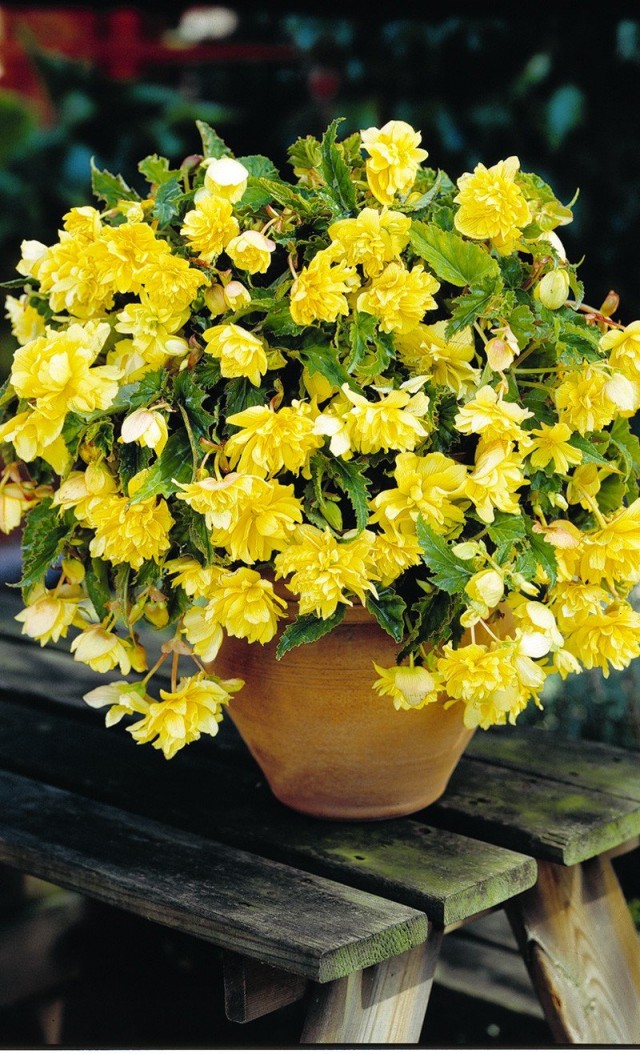 Flowering begonia cascading
Flowering begonia cascading
Reproduction
Cuttings
Propagation by cuttings, a quick and easy way to raise a new tiger beauty.
- Choose a medium-sized, healthy-looking stalk.Cut it off with a disinfected stationery blade and place it in damp ground.
- Place the glass in a warm, dark place (temperature +23 degrees).
- As soon as the roots appear, transplant the plant into a pot.
Seeds
Less popular breeding option. Seed material can be purchased at a specialized store, and it is better to choose the latter from two forms - regular and granular. Regular seeds are unprocessed seeds, while granular seeds are sold as dragees and are much easier to work with. But both are planted according to the same scheme:
- Soak the seeds in a weak solution of potassium permanganate (1%) for 30-45 minutes, and then rinse under running water. This will kill the pathogenic bacteria.
- Rinse the seeds and plant in a damp peat tablet, and place the tablet on a pallet under plastic or glass. The temperature in the room should be at least +20 degrees. Pour water into the tray from time to time to keep the tablet moist at all times.
- After 2-3 weeks, the first shoots should appear. As soon as the third leaf comes out, dive the plants into separate pots. The second pick is carried out 8 weeks after germination.
By dividing the bush
It is best to reproduce from the mother flower at the same time as the rejuvenation procedure, because the root system still has to be taken out of the soil.
Cut off a part or a piece of root protruding from the ground, powder the cut with ash (you can use charcoal and powdered activated carbon), let the cuttings dry for 30-40 minutes, and then plant them in pots with soil. Cover the containers with plastic wrap (or transparent glass) and place in a shaded place.
Useful video
Tiger begonia - breeding methods and growing mistakes at home:
Reproduction of room begonia Elatior
The adorable flowering begonias reproduce in the same way as everyone else. Elatiors are very rarely grown from seeds due to the loss of varietal properties of the offspring, but when buying individual varieties from trusted producers or bright mixtures, only pleasant surprises are likely to be expected.
The seeds are sown superficially, they are very small and require preliminary mixing with sand or sowing on sand. Germination requires a high temperature of 25 degrees and bright lighting. Plants develop slowly, they dive 2-3 times, several plants are placed in containers for a more decorative effect.
Very lush bushes of elatiors are most often in groups of several separate plants, and they willingly release side shoots. Separation is a very simple way of breeding and renewing these hybrid begonias. It is carried out during transplantation, carefully, removing all dry and damaged parts of both roots and shoots.
But nevertheless, cuttings remain the main breeding method of Elatior begonias. Non-flowering, vegetative shoots are chosen for him. You can cut green cuttings in both spring and summer. Apical and stem cuttings root in sand or any light / inert substrate that has been disinfected to protect plants from rot.
Elatior begonias require a temperature of about 20 degrees. Rooting is slow, up to 1 month, the plants require light moisture of the substrate and careful handling.
Reproduction by leaf cuttings for elatiors is very rarely used, but if all the rules are followed and very careful moistening, you can get new bushes in this way. Petioles about 3 cm long are carefully buried into the substrate in the same way as ordinary stem cuttings. Leaves take root in 2-3 months.
Begonias 'Nonstop' series
Moderator: Lucina
Begonias 'Nonstop' series
Post by gya »Jul 08, 2011 3:27 pm
Begonias of the Non-stop series - Begonia Non-Stop ‘Nonstop’
And here is another - tuberous begonia Non-Stop Red (Begonia Non-Stop Red). Last year, due to the intense heat, she could not show herself in all her glory. And now, having rested and accumulated strength during the rest period, this begonia strikes with large double flowers (10 cm in diameter) of a deep red-crimson color.
Re: Begonias 'Nonstop' series
Post by Milanashka »28 May 2013, 21:37
Non Stop Begonia yellow
Re: Begonias 'Nonstop' series
Posted by Olga 56 "May 30, 2013, 11:28 pm
Re: Begonias 'Nonstop' series
Posted by Bergamot on Jul 17, 2014 7:31 pm
Re: Begonias 'Nonstop' series
Posted by Margarita 66 "11 May 2015, 14:39
Begonia Nonstop Rose Pitticoat. The bush is compact and lush, they promise 20 cm in height, I still have 10. The first flower is 8 cm in diameter, the second is smaller for some reason, but this is just the beginning. As the name suggests, “Nonstop” - flowering should be continuous.
Re: Begonias 'Nonstop' series
Vitaly's message ”11 May 2015, 19:48
Re: Begonias 'Nonstop' series
Post by tashtanga »19 May 2015, 15:37
Re: Begonias 'Nonstop' series
Post by Lilek »May 27, 2015, 21:55
Re: Begonias 'Nonstop' series
Posted by Svyatoslav "May 27, 2015, 22:22
When and how to prepare begonias for the dormant period viewtopic.php? F = 265 & t = 9405
Methods for storing begonias tubers during dormancy viewtopic.php? F = 265 & t = 4382
Begonia tubers awakening after dormancy: how and when viewtopic.php? F = 265 & t = 8147
We share the results of the dormant period of tubers viewtopic.php? F = 265 & t = 7880
The importance of the degree of awakening of tubers at the time of planting viewtopic.php? F = 265 & t = 10414
Table of contents of the sub-forum “All about tuberous begonias” viewtopic.php? F = 265 & t = 10419
In this thread - a discussion of the features, flowering, etc. of begonias of the 'Nonstop' series
Begonias 'Nonstop' series
Post by lorson »Jun 04, 2016 8:14 pm
Begonias 'Nonstop' series
Post by Gibbs_Grom »Jun 10, 2016 9:57 pm
Begonias 'Nonstop' series
Post by Kseniya »Feb 12, 2017 10:37 pm
In 2016, she planted go-go and mocha, also wondered what the difference was. I grew both varieties from seeds, the flowers and leaves of the go-go were clearly smaller. Unfortunately, the go-go has not overwintered and therefore I cannot compare it with 2-year-old nonstops. Maybe it would have caught up in size.
Nonstop Mocca Pink Shades, Seed Growth, Summer 2016 Flowering
Begonias 'Nonstop' series
Post by Kseniya »Feb 16, 2017 09:43 am
Begonia Nonstop Mocca White. Grown from seed in 2015, just like the pink Mocca Pink Shades. In the photo, flowering in 2016. Two bushes gave flowers of different structure.
One plant has a corrugated edge and, at the same time, the peduncles are long:
And the second has an even edge, but the flower itself is terry, and looks like a rose, but the peduncles are too short, the flower is lost in the leaves.
Found a photo of Go-Go, flowering in 2016. Grown from seed, like Nonstop, but not in 2015, but in 2016, i.e. is a first year. In this case, the flower is fully formed, but the size is 2 times less than that of Nonstop.
{SOURCE}
Possible home care problems
- The leaf plates of the royal begonias are covered with brown spots due to direct sunlight. In this case, the plant must be rearranged to another place.
- The edges on the leaves dry out due to the low humidity.
- The leaves of the plant begin to lose their brightness and become thinner due to lack of light. In this case, begonia must be placed in diffused light.
- Leaves turn yellow due to insufficient nutrients or insufficient watering. Begonia must be regularly fed and irrigated.
Royal begonia can beautify any interior. You just need to make a little effort, and the plant will thank you with the splendor of bright foliage!

